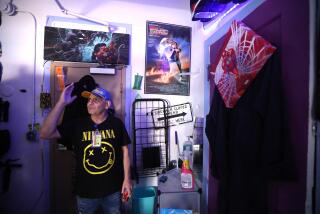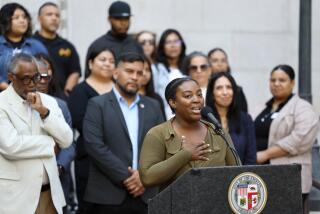Agency Fills Clients, Homes With New Hope
Tim McMillian never dreamed he’d one day live just yards from the ocean.
Diagnosed with HIV in 1983, McMillian has spent much of the past two decades struggling to make ends meet, at times staying with friends. By the late 1990s, he was spending $495 of his $600 monthly income to rent a studio apartment in Hollywood.
“I was barely, barely, barely getting by,” the 52-year-old said.
But McMillian’s life took a comforting turn after he entered a raffle and was selected to become a tenant at a Silver Lake apartment complex built by Project New Hope, a nonprofit that has been helping low-income and homeless families and individuals living with HIV and AIDS obtain housing since 1990. His rent dropped dramatically, and in April he moved to another Project New Hope building -- this one by the beach in Santa Monica.
“Never in my dreams did I think I’d be living in such a wonderful place, especially on my income,” McMillian said.
Although many people may feel squeezed by Southern California’s overheated housing market, according to Renee Ordeneaux, the group’s chief financial officer, those living with HIV or AIDS may also have extremely low incomes because their health prevents them from holding jobs.
“On average, our clients’ income is $671 a month,” Ordeneaux said. “The average rent in Los Angeles for a one-bedroom is $1,000 a month. It’s a problem.”
Half the people who receive housing through Project New Hope were previously homeless, Ordeneaux said. Some clients may also have drug or alcohol problems that make it difficult for them to find and keep housing.
A special sense of community takes hold at Project New Hope apartments, according to Martyn Camarillo, a resident services coordinator with the group, in part because residents may share similar challenges.
“Basically it’s a family,” said Camarillo, who makes weekly visits to three apartment complexes and touches base with his 47 clients at least once a month. “They help each other out with rides to the doctor and to food banks, especially right now, since there’s no transportation with the bus strike.”
In Los Angeles County, about 53,000 people live with HIV or AIDS and there are a limited number of housing services for those in need, according to Gunther Freehill, a spokesman for Los Angeles County’s Office of AIDS Programs and Policy.
Freehill described housing as health care, particularly for people with HIV.
“Housing is critical so people can live stable lives and consume HIV medical services,” he said. “Some of the HIV medications require refrigeration. That’s really tough to do when you don’t have a home.”
There are other potentially lifesaving reasons for providing housing for people who have HIV and AIDS, Ordeneaux added. “Someone living on the streets may continue to take drugs or resort to prostitution and are more likely to continue transmitting the disease,” she said.
Hundreds of names, however, fill the wait lists for apartment complexes offered by Project New Hope, which relies on a combination of private donations and government funding.
The group has constructed, leased or refurbished about 125 units in Hollywood, San Pedro, Santa Monica, Silver Lake, South Los Angeles and Pico Union. It is now building a 25-unit apartment complex in South Los Angeles, which is scheduled to open in April.
Since merging with Homestead Hospice and Shelter in 2000, Project New Hope has also offered transitional housing at two facilities with 20 beds in residential neighborhoods in Pico Union and Lawndale. The facilities prepare people who were previously homeless for independent apartment living.
For those unable to live on their own, the group has three additional facilities in Long Beach, West Hills and Van Nuys with 24-hour staffing. The 22 beds provide residents with an alternative to hospitals, nursing homes or, in worst cases, the street.
Despite advancements in medicine, Ordeneaux contends that the need for housing persists because, “the AIDS epidemic is not over.” The Centers for Disease Control and Prevention delivered a troubling announcement in July that the number of new AIDS cases in the United States had increased for the first time in a decade.
The deadly disease hit Project New Hope particularly hard last year, when 11 of the 165 clients living in permanent housing died; many of them were in their 40s and 50s, according to Ordeneaux.
“It’s the highest rate of death we’ve had in the last five years,” Ordeneaux said. “The epidemic is continuing to spread, with Latinos and African Americans disproportionately hit in terms of new infections.”
Ordeneaux estimated that 40% of the clients served by her group are Latino.
McMillian is one of 700 people aided annually by Project New Hope with housing, computer training courses and a variety of services aimed at getting clients into housing and keeping them there. Services include money management courses, career development and referrals to food banks, as well as health and mental health services.
The services have reduced McMillian’s stress level. He no longer lives from paycheck to paycheck; nor does he have to hit up friends for help with food and housing.
After he moved to the Jack H. Plimpton New Hope Apartments in Silver Lake in 1998, McMillian’s rent went from practically consuming his monthly Social Security disability check to taking less than a third of it.
The one-bedroom unit featured central air and heat and a washer and dryer and was close to shopping and bus lines. The apartments, the first constructed by the group, were named for Jack H. Plimpton, a retired Los Angeles school principal who, with the Episcopal Diocese of Los Angeles, helped found Project New Hope in 1990.
McMillian said he has also benefited from computer training courses and counseling offered by Project New Hope, in addition to help with his medication and doctors.
In April, McMillian, who has worked as a waiter and a short-order cook, got his first taste of beach living when he moved to Santa Monica. He pays $182 a month in rent.
These days he focuses his energy on obtaining his general equivalency diploma. His hopes include counseling kids struggling with alcohol or drug problems or who are living with HIV.
“I’d like to show them there’s hope and that you don’t have to give up on life,” McMillian said.
More to Read
Sign up for Essential California
The most important California stories and recommendations in your inbox every morning.
You may occasionally receive promotional content from the Los Angeles Times.






